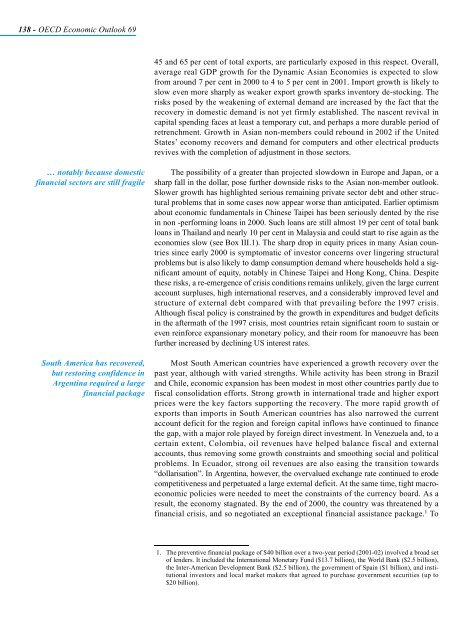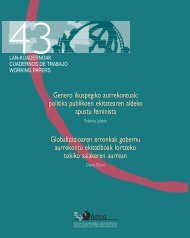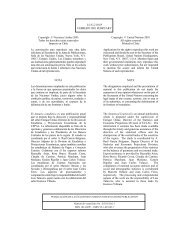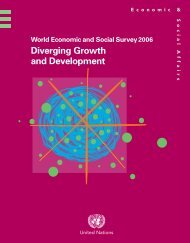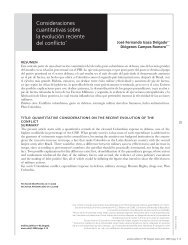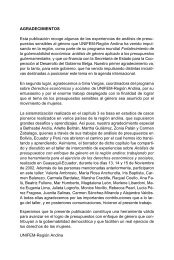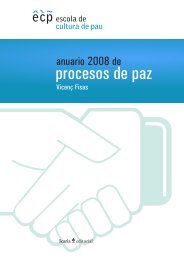OECD Economic Outlook 69 - Biblioteca Hegoa
OECD Economic Outlook 69 - Biblioteca Hegoa
OECD Economic Outlook 69 - Biblioteca Hegoa
Create successful ePaper yourself
Turn your PDF publications into a flip-book with our unique Google optimized e-Paper software.
138 - <strong>OECD</strong> <strong>Economic</strong> <strong>Outlook</strong> <strong>69</strong><br />
… notably because domestic<br />
financial sectors are still fragile<br />
South America has recovered,<br />
but restoring confidence in<br />
Argentina required a large<br />
financial package<br />
45 and 65 per cent of total exports, are particularly exposed in this respect. Overall,<br />
average real GDP growth for the Dynamic Asian Economies is expected to slow<br />
from around 7 per cent in 2000 to 4 to 5 per cent in 2001. Import growth is likely to<br />
slow even more sharply as weaker export growth sparks inventory de-stocking. The<br />
risks posed by the weakening of external demand are increased by the fact that the<br />
recovery in domestic demand is not yet firmly established. The nascent revival in<br />
capital spending faces at least a temporary cut, and perhaps a more durable period of<br />
retrenchment. Growth in Asian non-members could rebound in 2002 if the United<br />
States’ economy recovers and demand for computers and other electrical products<br />
revives with the completion of adjustment in those sectors.<br />
The possibility of a greater than projected slowdown in Europe and Japan, or a<br />
sharp fall in the dollar, pose further downside risks to the Asian non-member outlook.<br />
Slower growth has highlighted serious remaining private sector debt and other structural<br />
problems that in some cases now appear worse than anticipated. Earlier optimism<br />
about economic fundamentals in Chinese Taipei has been seriously dented by the rise<br />
in non -performing loans in 2000. Such loans are still almost 19 per cent of total bank<br />
loans in Thailand and nearly 10 per cent in Malaysia and could start to rise again as the<br />
economies slow (see Box III.1). The sharp drop in equity prices in many Asian countries<br />
since early 2000 is symptomatic of investor concerns over lingering structural<br />
problems but is also likely to damp consumption demand where households hold a significant<br />
amount of equity, notably in Chinese Taipei and Hong Kong, China. Despite<br />
these risks, a re-emergence of crisis conditions remains unlikely, given the large current<br />
account surpluses, high international reserves, and a considerably improved level and<br />
structure of external debt compared with that prevailing before the 1997 crisis.<br />
Although fiscal policy is constrained by the growth in expenditures and budget deficits<br />
in the aftermath of the 1997 crisis, most countries retain significant room to sustain or<br />
even reinforce expansionary monetary policy, and their room for manoeuvre has been<br />
further increased by declining US interest rates.<br />
Most South American countries have experienced a growth recovery over the<br />
past year, although with varied strengths. While activity has been strong in Brazil<br />
and Chile, economic expansion has been modest in most other countries partly due to<br />
fiscal consolidation efforts. Strong growth in international trade and higher export<br />
prices were the key factors supporting the recovery. The more rapid growth of<br />
exports than imports in South American countries has also narrowed the current<br />
account deficit for the region and foreign capital inflows have continued to finance<br />
the gap, with a major role played by foreign direct investment. In Venezuela and, to a<br />
certain extent, Colombia, oil revenues have helped balance fiscal and external<br />
accounts, thus removing some growth constraints and smoothing social and political<br />
problems. In Ecuador, strong oil revenues are also easing the transition towards<br />
“dollarisation”. In Argentina, however, the overvalued exchange rate continued to erode<br />
competitiveness and perpetuated a large external deficit. At the same time, tight macroeconomic<br />
policies were needed to meet the constraints of the currency board. As a<br />
result, the economy stagnated. By the end of 2000, the country was threatened by a<br />
financial crisis, and so negotiated an exceptional financial assistance package. 1 To<br />
1. The preventive financial package of $40 billion over a two-year period (2001-02) involved a broad set<br />
of lenders. It included the International Monetary Fund ($13.7 billion), the World Bank ($2.5 billion),<br />
the Inter-American Development Bank ($2.5 billion), the government of Spain ($1 billion), and institutional<br />
investors and local market makers that agreed to purchase government securities (up to<br />
$20 billion).


